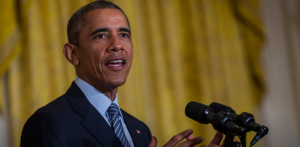Obama’s Flexible Fix to Climate Change
< < Go Back
by Joe Nocera,
For many years, I used to spend at least part of the summer in the gorgeous Laurentides region of Quebec, an hour northwest of Montreal. By the mid-1980s, with each return trip, I could see a growing environmental threat to the area’s beauty: More and more trees were dying. When I asked people what was happening, the answer was simple: “pluie acide,” or acid rain, a form of pollution caused by sulfur dioxide and nitrogen oxides that were spewing from coal-fired power plants in America.
A decade or so later, the trees had stopped dying. An environmental disaster had been averted. What had happened?
The answer was that the administration of the first President George Bush, working hand in glove with the Environmental Defense Fund, devised a market-based plan, now known as cap-and-trade, to reduce sulfur dioxide emissions. Congress passed it in 1990. The brilliance of the scheme is that while it set emissions targets, it did not tell power companies how to meet those targets, allowing them a great deal of flexibility. It also provided a financial incentive: Companies that cut their pollution beyond their caps could trade their leftover emission allowances to companies that were having trouble staying under the limit.
Industry officials and many state officials complained bitterly about the new system, saying it would be costly and tie companies up in regulatory knots. But that’s not what happened. “Industry had incentive to innovate,” recalls Fred Krupp, the president of the Environmental Defense Fund. As an interim measure, power companies began using low-sulfur coal while they worked to come up with better and more affordable scrubbers. Today, average levels of sulfur dioxide pollution are 76 percent lower than they were in 1990. The cost has been far less than the critics feared.
On Monday afternoon, President Obama unveiled his Clean Power Plan, formalizing some tough new rules from the Environmental Protection Agency that are aimed at reducing the carbon emitted by power companies. There is no bigger source of carbon pollution; the goal is that by 2030, carbon emissions will be reduced by 32 percent from their 2005 level. In the fight against climate change, nothing is more important.
Once again, opponents are up in arms, forecasting calamity for the utility industry if the rules are allowed to stand, with at least a dozen states planning to sue the E.P.A. The attorney general of West Virginia, Patrick Morrisey, has said the regulations would lead to “reduced jobs, higher electricity rates” and increased stress on the power grid. Mississippi’s Republican governor, Phil Bryant, described the E.P.A. plan as “burdensome.”
And then there’s Mitch McConnell, the Senate majority leader, whose state, Kentucky, is in the heart of coal country. He has openly called on states to defy the E.P.A. On Monday, he described the new rules as “a triumph of blind ideology over sound policy and honest compassion.”
But just as with the acid rain controversy, the opponents of the new emission-reduction rules have it exactly backward. The E.P.A. rules have a far greater chance of creating jobs, being less burdensome and epitomizing sound public policy than the opposite.
The single most important fact about the new regulations is that they don’t tell utilities how to get their emissions down. Instead, they allow the states flexibility to figure out how to lower their own emissions. Some may choose a cap-and-trade system — as California and nine states in the Northeast have already done to great effect.
More From The New York Times:




